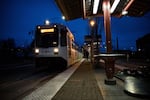A replacement for the Interstate 5 bridge connecting Oregon and Washington will likely include light rail, a longstanding issue between stakeholders on either side of the two states’ border.
Staff members planning the massive replacement effort briefed officials on Thursday and laid out various bridge designs — such as interchanges and auxiliary lanes — and offered suggestions. Among their strongest: to include light rail, a recommendation many officials who will decide the future of the project embraced.

The Albina-Mississippi TriMet MAX stop in Portland, Oregon, Saturday, Dec. 15, 2018.
Bradley W. Parks / OPB
Many leaders on the Washington side, where light rail has in the past been painted as a costly albatross, responded favorably. Vancouver Mayor Anne McEnerny-Ogle said bringing a light rail station into the city will give more transit options for her constituents.
“We need more options,” McEnerny-Ogle said. “We’re growing.”
A few leading voices on the north side of the river, however, said they still had concerns.
The bridge project, estimated to cost up to $5 billion, is required by federal guidelines to include a mass transit option. Until Thursday, however, it had been unclear if the seven governments involved — cities, transit agencies, regional planning entities — could find a consensus.
In Portland, TriMet has for years operated its MAX light rail. The transit agency has also invested in bus rapid transit, which often deploys larger buses in dedicated lanes to speed up routes. Clark County’s transit authority, C-Tran, has recently invested millions in bus rapid transit and expects to have three routes open before the new bridge is constructed.
Thursday’s revelations do not officially lock in light rail as the option. An executive steering group and state lawmakers must still officially vote on the matter in May.
However, it does signal light rail has momentum. Of the four preferred plans presented by staff, all included light rail.
Washington Sen. Lynda Wilson, R-Vancouver, said in a meeting with other state lawmakers about the bridge on Thursday that she felt like “the train has left the station.” She said she worried costs of light rail could still fall on Southwest Washington residents’ shoulders.
“The question has to be asked: Does light rail make sense in Clark County?” Wilson told OPB.
On costs, McEnerny-Ogle said she expected Clark County residents wouldn’t pay an undue burden. The funding for the bridge, she said, would pay for the construction of light rail stations. Ongoing costs, she added, should be paid by TriMet.
“We expect TriMet to pay for their system, and for us to pay for ours,” McEnerny-Ogle said.
Light rail has long been a sore spot when discussions revolved around replacing the Interstate 5 bridge. The last replacement attempt died when Washington lawmakers walked away over plans to include light rail.
Those concerns have not subsided, according to U.S. Rep. Jaime Herrera Beutler, who represents Southwest Washington. On Thursday, she sent out a missive to express disappointment that light rail was once again being considered.
“This decision flies in the face of Southwest Washington voters who have soundly and repeatedly rejected bringing Portland’s light rail to Washington state along with the massive cost, river traffic limitations and public safety concerns that come with it,” Herrera Beutler wrote in a prepared statement.
Staff who have been analyzing the logistics, costs and potential benefits of a new bridge said it continues to make sense to include light rail.
Their takeaways say light rail would allow the new bridge to maximize the number of trips across, preserve Clark County’s current bus rapid transit configuration and future plans, as well as allow the project to be more competitive in acquiring grants from the Federal Transit Authority.

A file photo shows the Interstate 5 bridge spanning the Columbia River between Oregon and Washington states, between Portland, Ore., and Vancouver, Wash.
Rick Bowmer / AP
The extension of the MAX yellow line, which currently ends at the Portland Expo Center, also represents the best investment to integrate the bridge into the region’s existing transit network.
According to staff, light rail will cost more to build but will result in lower operational costs per rider.
Thursday’s announcement was also applauded by Metro Council President Lynn Peterson, a mass transit advocate whose earlier career stops included leading the Washington Department of Transportation. She called the decision a “big win” for thousands of regional bridge users who might soon be able to cross the river without driving.
“It’s so great to get to this point of the conversation where we’ve got information so we can see the trade-offs,” she said. “(It’s also) a big win for the region and its efforts towards mobility equity and climate goals.”
An executive steering committee overseeing the bridge project — on which Peterson and McEnerny-Ogle both sit — will meet again on May 5 to finalize which design options to pursue.


